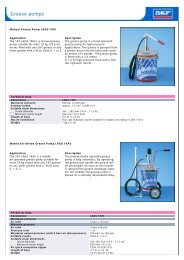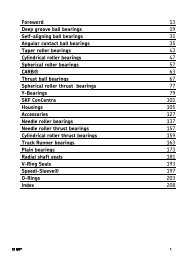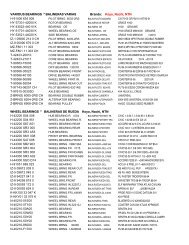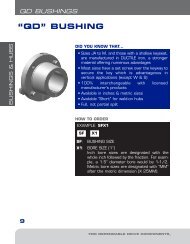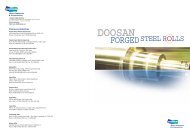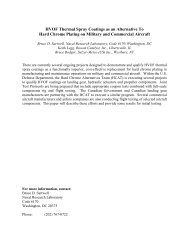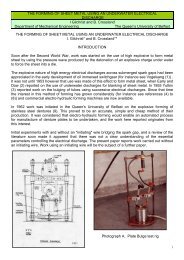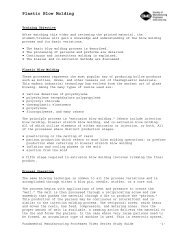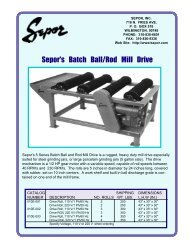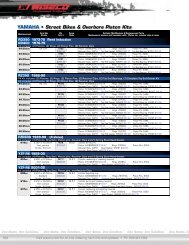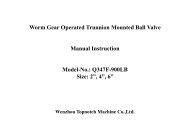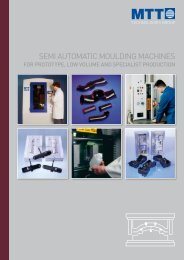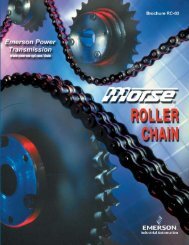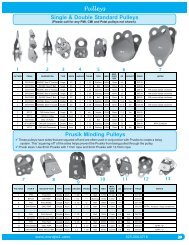Centrifugal Casting
Centrifugal Casting
Centrifugal Casting
You also want an ePaper? Increase the reach of your titles
YUMPU automatically turns print PDFs into web optimized ePapers that Google loves.
<strong>Centrifugal</strong> <strong>Casting</strong><br />
BENEFITS OF CENTRIFUGAL CASTING<br />
CENTRIFUGAL PROCESS<br />
Virtually Shrinkage Free<br />
• Solidification occurs from the OD inward. <strong>Casting</strong>s are designed to have<br />
the ID be the last metal to freeze.<br />
This effectively makes the ID the casting’s “riser”.<br />
• <strong>Centrifugal</strong> force literally “squeezes” molten metal into shrinkage voids as<br />
they are formed.<br />
• The resulting casting is thus very dense especially when compared to a<br />
static casting.<br />
Secondary Refining<br />
• <strong>Centrifugal</strong> force spins the more dense material (the metal) to the OD of<br />
the molten casting.<br />
• The less dense material (the dirt, dross, or slag) spins preferentially to the<br />
bore.<br />
• These non-metallics are removed in subsequent machining operations<br />
leaving a very clean, very dense end product.<br />
TOP 5 BENEFITS OF CENTRIFUGALLY CAST<br />
HYDRAULIC CYLINDERS<br />
1. Integrally Cast Flanges<br />
2. Quantity Flexibility<br />
3. Delivery of Non-Standard Sizes<br />
4. Alloy Flexibility<br />
5. Availability of Heavy Wall Thickness<br />
1. Integrally Cast Flanges<br />
The centrifugal casting process allows some shaping of the outer diameter of the workpiece. As long<br />
as the shaping is graduated in a manner that allows the part to be removed from the die, the shape can<br />
be cast integrally. This feature was an important factor in off-road truck manufacturers switching from<br />
welded construction to centrifugals. Typically, large heavy walled cylinders are flanged to<br />
accommodate the high pressures exhibited on the end seals. Welded construction utilizes seamless
tubing or forged tubing (often economical when purchased in quantity) with a forged flange welded on<br />
one or both ends. The weld must be full penetration for safety reasons.<br />
Subsequently, this assembly must then go through post weld heat treatment to achieve acceptable<br />
mechanical properties. An integrally cast flange from the centrifugal process will achieve strengths in<br />
excess of four times (4X) that of the welded/heat treated equivalent. For this reason alone,<br />
manufacturers have readily accepted centrifugal castings for their critical cylinder bodies.<br />
2. Quantity Flexibility<br />
While large regular runs are easily accommodated, centrifugal castings are particularly suited to smaller,<br />
job-specific runs. At Spuncast, seamless, DOM tubing, or tube mill manufacturing can be very economical<br />
when purchased in large quantities or “mill runs”. Yet, because each centrifugally cast tube is usually an<br />
"individual" furnace heat, single piece or small quantities will not drastically change the cost.<br />
3. Delivery of Non-Standard Sizes<br />
The centrifugal casting process lends itself extremely well to non-standard sizes. The dies, while not<br />
inexpensive, are manageable both financially and in lead time. The dies shape and size only the outer<br />
diameter of the casting while the amount of molten metal poured sizes the inner diameter. When<br />
engineers design cylinders for a specific duty, there are many times when standard pipe sizes are not<br />
available in the required diameter or the desired wall thickness. <strong>Centrifugal</strong> castings are an excellent<br />
solution to this dilemma.<br />
4. Alloy Flexibility<br />
This is an outstanding benefit for using centrifugal castings in hydraulic cylinder applications. Through<br />
metallurgical control and a quench facility designed specifically for tubular parts, Spuncast is able to<br />
achieve extremely good and extremely repeatable mechanical properties from low alloy steels. This<br />
makes our tubes usable in many high pressure applications. It is also possible to pour high strength<br />
stainless alloys, such as 17-4PH, duplex stainless steels, or super duplex stainless steels. Spuncast has<br />
the metallurgical experience and expertise to pour each of these alloys.<br />
5. Availability of Heavy Wall Thickness<br />
<strong>Centrifugal</strong> casting facilitates the production of heavy walled cylinders. Wall thicknesses of 30 mm to 65<br />
mm are possible and common. Other methods of manufacturing are either incapable of these dimensions<br />
or would be cost-prohibitive. <strong>Centrifugal</strong> casting offers an economical means to meet design<br />
requirements.<br />
Summary:<br />
There are numerous processes used to produce Hydraulic Cylinder Bodies. Each can be<br />
economically appropriate in specific situations. The benefits outlined above show that the centrifugal<br />
casting process should definitely be considered when designing and purchasing cylinder bodies.<br />
Spuncast Sales Engineers are available to help determine if centrifugal casting would be an economical<br />
option for a particular hydraulic application.



